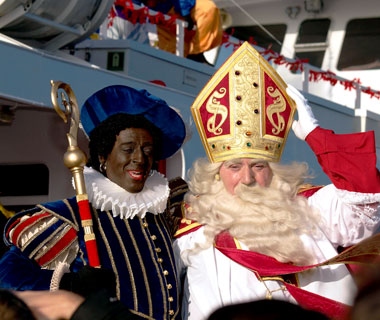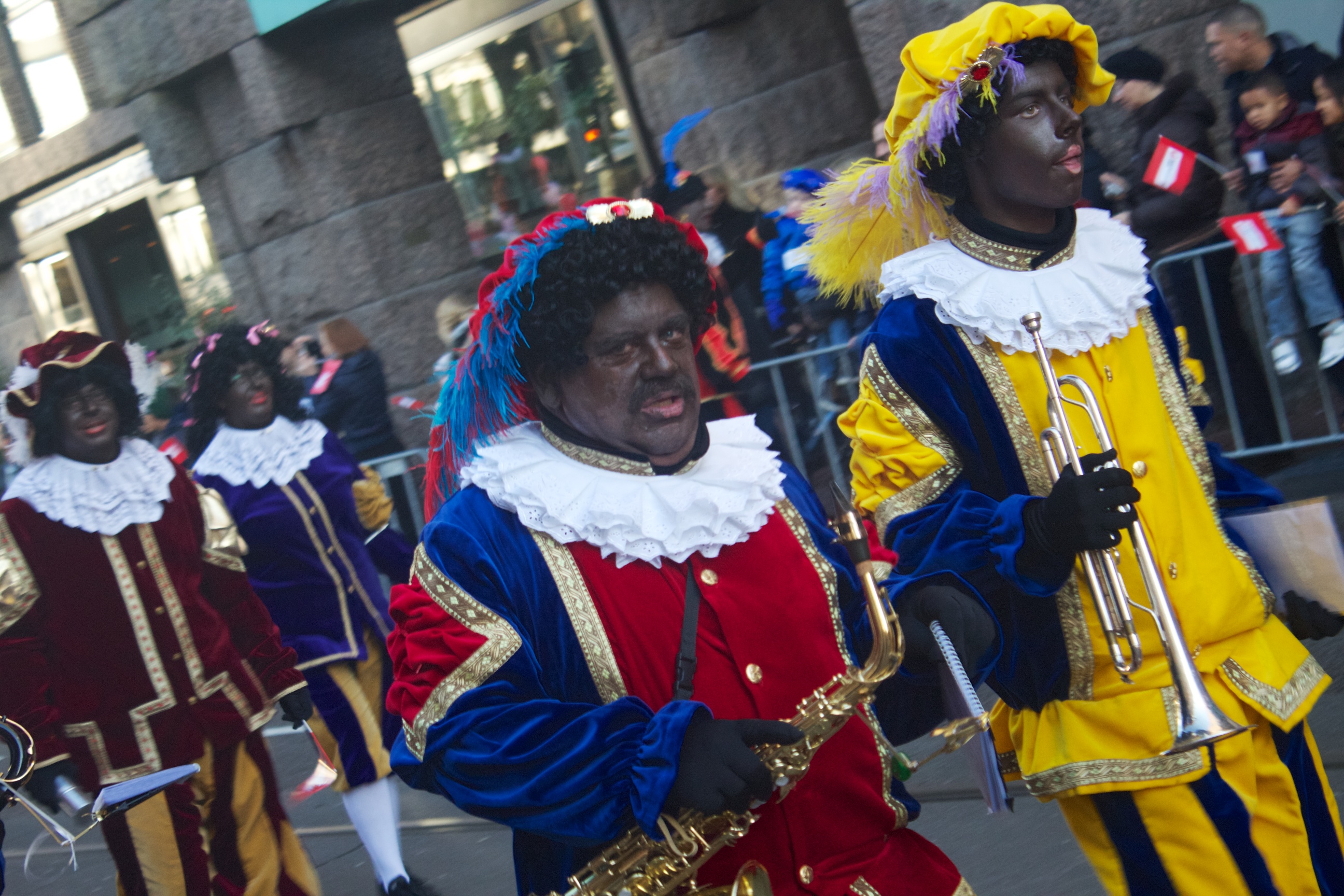From The Guardian "Black Pete exposes the Netherlands' problem with race: White people dressing up as fools with black faces is not the harmless Christmas fun that the Dutch make it out to be," by Siji Jabbar, on 5 December 2012-- I once heard a joke that went something like this: when the world is coming to an end, move to the Netherlands because everything happens there 50 years later. A bit harsh, I thought, after all, the Dutch are a relatively progressive people with much to recommend them: from the high level of volunteering to absence of hysteria around subjects such as cannabis, prostitution, same-sex marriage and euthanasia. On the matter of race, though, you do wonder. Particularly around this time of year, by way of a character called "Zwarte Piet" (Black Pete).

In America you have Santa Claus, in the UK he's Father Christmas, and in the Netherlands he's called Sinterklaas. Unlike the other Santas, though, the Dutch Sinterklaas arrives with his slave/servant called Zwarte Piet. The slave-servant comes dressed like a renaissance minstrel: black face, painted red lips, afro wig. The arrival is a huge event: Sinterklaas and the Zwarte Pieten make a grand entrance, and the whole parade is broadcast on public television. Sinterklaas sits tall on a white horse while his black servants share out candy to the kids on the sidelines, and families from all over the country turn up to watch. Or course, there are always several Black Petes, typically played by white people, all in blackface, with red painted lips and afro wigs.

The transformation, however, is not complete with the outfit and greasepaint. The character must speak poor Dutch with a stupid accent, and must act childlike and mischievous when performing. And from mid-November, when Sintaklass and his servants arrive, you can see Zwarte Pieten all over, on television programmes and commercials and on the streets, acting the fool.
At schools across the country, children sing songs referring to the skin tone and character of the black servant "...even if I'm black as coal I mean well…", "Saint Nicolas, enter with your black servant", etc, and there are other old songs about Zwarte Piet in which he's made out to be a little bit stupid, a little bit clumsy, more akin to a child than an adult, the same generalizations previously applied to black people, but which can no longer be made explicitly.
What on is going on with the Dutch? How can such an abhorrent anachronism exist in a seemingly modern and progressive country? As one writer put it, "millions of black people were killed or enslaved by white people over four centuries, and millions more continue to suffer discrimination all over Europe and in the States, so this Zwarte Piet character is about as funny as wearing a swastika."
As I hinted in the first paragraph, Zwarte Piet is not the only sign that the Dutch have a problem with race. Dutch society also has more subtle ways of reminding black people of their place and keeping them there. If you spend any time in the Netherlands, you will soon hear the words "allochtoon" used in polite conversation.

People of "non-western" descent are labeled "allochtoon", not only by the white society, but also by law. "Allochtoon" is based on a Greek word, "allokhthon", and means "found in a place other than where they were formed". But no non-Dutch white person living in the Netherlands is referred to as allochtoon, only non-white people, Dutch and otherwise. These allochtonen, the "outsiders" (many of whom were born and raised in the Netherlands) are the ones typically accused by the right-wing politician Geert Wilders and others of exploiting the country's resources and social services while not integrating properly into Dutch society. The word allochtoon is thus used as a continuous reminder to people of colour in the Netherlands that white-Dutch people simply do not see them as an equal member of the society, let alone as Dutch, no matter multi-cultural said society might appear on the surface.
Yet a fifth of the Dutch population consists of people of colour. This includes people from former colonies such as Indonesia and Surinam, but also people whose roots lay in Morocco and Turkey. Since the 1980s, there has also been a steady stream of migrants from sub-Saharan Africa to the Netherlands. Some of them are now grandparents, with kids and grandkids who consider the Netherlands home (or try to, at any rate). All of these people are "allochtoon".
In this context, one can start to understand why the unemployment rate of non-white Dutch people (at 15% in the first quarter of 2012) is two-and-a-half times higher than the Dutch average. One also starts to understand why black and white Dutch people see nothing wrong with a film like Alleen Maar Nette Mensen ("Only Decent People") or why, in December last year, the editor of Dutch fashion magazine Jackie thought it was okay to give its readers fashion advice that they could dress like a "Nigga Bitch", associating the style with Rihanna. Rihanna, of course, didn't hold back in her response (she's not black Dutch, so one imagines she didn't know her place), and the editor was forced to resign. But here's the thing, many white and black people felt the editor would have kept her job, if the controversy hadn't been picked up outside the Netherlands. Those who objected were labelled "too sensitive". When the editor was first confronted about the racist slur, her response was that it was just a "bad joke".
Why do people keep defending Zwarte Piet? Is it that they really can't see that it is racist or that they don't want to see? One blogger (Toby Sterling) writes that actually, the people who defend Zwarte Piet know all to well that he is a racist caricature, but that they are experiencing the psychological phenomenon known as "cognitive dissonance": the brain filters out new information (Zwarte Piet is a racist caricature) that conflicts with what one already believes (I love Zwarte Piet and I am not a racist).
You don't have to have a degree in psychology or sociology to work out that the figure of Zwarte Piet, and the use of words like "neger" and "allochtoon" ensure the continued internalisation of ideas of superiority of white Dutch people, and of inferiority and marginalisation of black Dutch people. Nor do you need it to understand the associate power of symbols like Zwarte Piet. You can keep a symbolic boot on someone's neck, and it can be just as effective as doing so physically, more so, even.
The debate is also, as Lulu Wang writes, a discussion about citizenship and identity. "And because this discussion does not take place behind closed doors between politicians and intellectuals only, but in schools, between colleagues, family-members and friends, it offers us a chance to challenge old conceptions of self and other at many different levels. However, this annual debate is not sufficient to change things, but it can lead to more activism, a critical outlook and recognition of those situations where the same strategies of marginalisation are being used. The Black servant and his White master can not be isolated from the social context, Dutch society, in which they exist."
In researching this piece, and from discussing it with Dutch people, black and white, I discovered that this debate has been going on for years, every year. Initially, I thought that was cause for concern. Perhaps the defenders of the "tradition" believe so long as they don't listen to anything the black Dutch people say, the debate will never get beyond talk, and the anti-Piet campaigners will give up from exhaustion. But I was reassured that the numbers (black and white) of those against this "tradition" are indeed growing.
Playwright Mark Walraven, for instance, says he used to be one of the many white men who would paint their faces black each year to the delight of children. "I stopped after I began working with black people," he said. "Many people are offended by this symbol."
Four years ago, Walraven put on a play In the Shadow of the Saint about the debate over Black Pete at Amsterdam's Krater Theater. One of messages of his play is that you can still have Sinterklaas without Black Pete. "Many countries have abolished these kinds of things but in Holland they still exist," Walraven said. "Nevertheless, most Dutch don't consider themselves to be racist and feel they are being personally attacked when you criticise Black Pete," he said.
"The majority here in Holland refuse to talk about Black Pete. They are afraid that the people who discuss it want to take away Sinterklaas as a phenomenon." (source: The Guardian)










THat is so ridiculous. Krampus needs to kick their asses!
ReplyDeleteI hope he wears the new Nike "Krampus" shoes.
Deletepfff krampus cant stop a land's tradition so FUCK YOU
DeleteHey Ron,
ReplyDeleteWatch this miserable program from the Kellogg Foundation, it's like the "Negro Problem" revisited. This is disturbing, who are these asshole panelists?
http://youtu.be/d83vlBp4gOk
this is bullshit it is not racist it is a tradition that is ages old and i know a lot of black people who dont care
ReplyDeleteYep correct...
DeleteThe person who wrote this is black for sure!! What kind of psychological problems do you have?? We don't make a fool of zwarte Piet and he just speaks Dutch not half Dutch!! And the songs are not racists!!!you have a big problem!zwarte Piet is black because of climbing in the chimney!!!
ReplyDelete